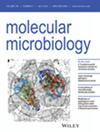YabG 突变对艰难梭菌孢子萌发和孢子底物加工的影响
IF 2.6
2区 生物学
Q3 BIOCHEMISTRY & MOLECULAR BIOLOGY
引用次数: 0
摘要
YabG 是一种孢子特异性蛋白酶,在孢子细菌中是保守的。艰难梭菌 YabG 将皮层注定蛋白 preproSleC 加工成 proSleC,将 CspBA 加工成 CspB 和 CspA。YabG 还影响孢子衣/外孢子蛋白 CotA 和 CdeM 的合成。在之前确定 CspA 为共萌发受体的工作中,发现 yabG 中的突变改变了启动孢子萌发所需的共萌发受体。为了了解 yabG 基因座上的这些突变是如何促进艰难梭菌孢子萌发的,我们将这些突变引入了一个同源背景中。艰难梭菌 yabGC207A(催化不活跃的等位基因)、艰难梭菌 yabGA46D、艰难梭菌 yabGG37E 和艰难梭菌 yabGP153L 株系的孢子仅在牛胆酸的作用下萌发。重组表达和纯化的 preproSleC 与表达野生型 YabG 的大肠杆菌裂解物孵育后,preproSleC 的前序被去除。有趣的是,只有 YabGA46D 对纯化的 preproSleC 有活性。对 preproSleC 中 YabG 处理位点(R119A)的突变导致 YabG 将其处理转移到 R115 或 R112。最后,使用 SNAP 标记分析了突变启动子下 YabG 表达的变化,结果显示在孢子形成的早期和晚期存在表达差异。总之,我们的研究结果支持并扩展了一个假设,即 YabG 对萌发和孢子的组装非常重要,而且一旦加工位点发生突变,它就会转移裂解底物的位置。本文章由计算机程序翻译,如有差异,请以英文原文为准。
The Impact of YabG Mutations on Clostridioides difficile Spore Germination and Processing of Spore Substrates
YabG is a sporulation‐specific protease that is conserved among sporulating bacteria. Clostridioides difficile YabG processes the cortex destined proteins preproSleC into proSleC and CspBA to CspB and CspA. YabG also affects synthesis of spore coat/exosporium proteins CotA and CdeM. In prior work that identified CspA as the co‐germinant receptor, mutations in yabG were found which altered the co‐germinants required to initiate spore germination. To understand how these mutations in the yabG locus contribute to C . difficile spore germination, we introduced these mutations into an isogenic background. Spores derived from C . difficile yabG C207A (a catalytically inactive allele), C . difficile yabG A46D , C . difficile yabG G37E , and C . difficile yabG P153L strains germinated in response to taurocholic acid alone. Recombinantly expressed and purified preproSleC incubated with E . coli lysate expressing wild type YabG resulted in the removal of the presequence from preproSleC. Interestingly, only YabGA46D showed any activity toward purified preproSleC. Mutation of the YabG processing site in preproSleC (R119A) led to YabG shifting its processing to R115 or R112. Finally, changes in yabG expression under the mutant promoters were analyzed using a SNAP‐tag and revealed expression differences at early and late stages of sporulation. Overall, our results support and expand upon the hypothesis that YabG is important for germination and spore assembly and, upon mutation of the processing site, can shift where it cleaves substrates.
求助全文
通过发布文献求助,成功后即可免费获取论文全文。
去求助
来源期刊

Molecular Microbiology
生物-生化与分子生物学
CiteScore
7.20
自引率
5.60%
发文量
132
审稿时长
1.7 months
期刊介绍:
Molecular Microbiology, the leading primary journal in the microbial sciences, publishes molecular studies of Bacteria, Archaea, eukaryotic microorganisms, and their viruses.
Research papers should lead to a deeper understanding of the molecular principles underlying basic physiological processes or mechanisms. Appropriate topics include gene expression and regulation, pathogenicity and virulence, physiology and metabolism, synthesis of macromolecules (proteins, nucleic acids, lipids, polysaccharides, etc), cell biology and subcellular organization, membrane biogenesis and function, traffic and transport, cell-cell communication and signalling pathways, evolution and gene transfer. Articles focused on host responses (cellular or immunological) to pathogens or on microbial ecology should be directed to our sister journals Cellular Microbiology and Environmental Microbiology, respectively.
 求助内容:
求助内容: 应助结果提醒方式:
应助结果提醒方式:


